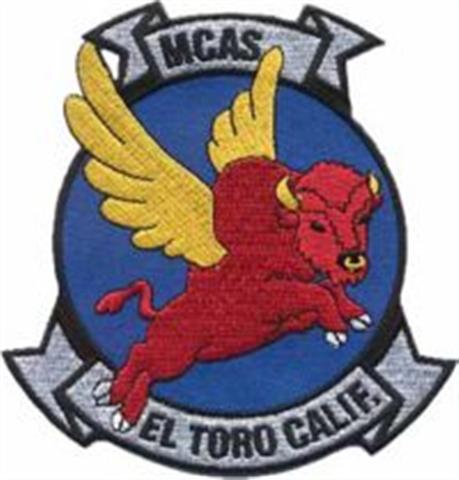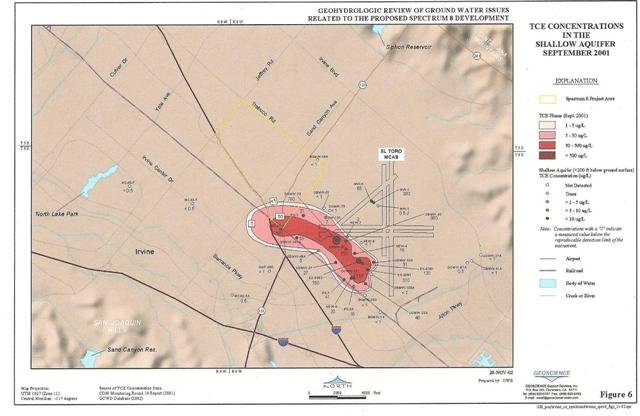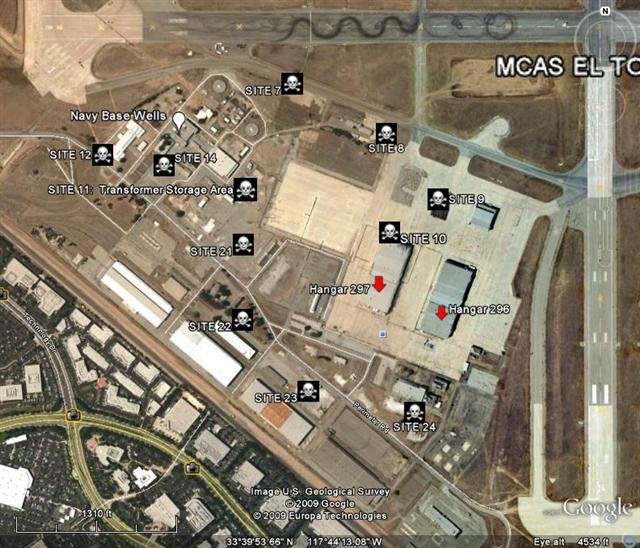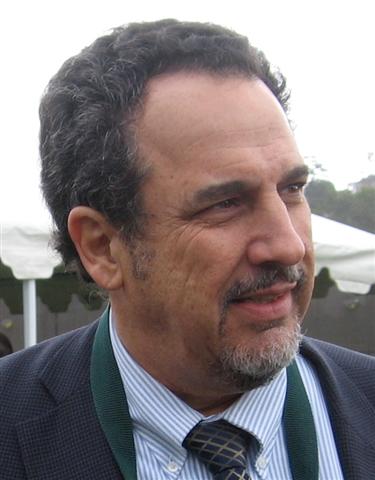Veterans of former Marine Wing Support Group-37, MCAS El Toro, California are unaware of their risk of exposure to carcinogens and many have ‘not connected the dots ‘of illness to military service.
UPDATED OCTOBER 2, 2010
(IRVINE, CA) – Hundreds and maybe thousands of 55 gallon drums of trichloroethylene (TCE) and perchloroethylene (PCE) were used at MCAS El Toro over decades to degrease aircraft parts.
A major concern is that both chemicals are carcinogens, the men using them did not wear protective clothing and masks, and the waste were dumped into storm drains or directly in the ground. The unintended results were extensive contamination of soil and groundwater and increased risks of cancer and other serious health effects.
The unintended results were extensive contamination of soil and groundwater and increased risks of cancer and other serious health effects.
No follow-up was made by any government agency to alert Marine veterans of their possible exposure to toxic chemicals and their health effects. Even when the government is grossly negligent, veterans have no rights to sue for injuries from active duty.
Veteran Service Organizations like the American Legion, VFW, and Marine Corps League have NOT alerted their memberships to risks of exposure and health effects to contaminants of concern at El Toro or the other 130 military bases on the National Priority List (EPA Superfunds). This information is readily available from the EPA Superfund database.
If a veteran is successful in ‘connecting the dots’ of illness to military service, the only alternative is to file a VA disability and compensation claim. However, the backlog of VA claims and the requirement for a medical nexus opinion linking a current medical condition (e.g., bladder cancer) to military service is a long shot at best. Unlike Agent Orange exposure for Vietnam veterans, there’s no presumptive disability for veterans exposed to toxic chemicals and apparently the government likes it that way.
After TCE was banned from use, the chemicals continued to be used at El Toro. The official Navy and EPA reports state that TCE/PCE was discontinued in the mid-1970’s. Don’t believe it. Reports from Marine veterans on the base in the 1990’s note that TCE was such a good solvent that it continued to be used despite the official policy of nonuse. Drums of TCE waste were buried to hide them from the Marine Corps Inspector General during on-site inspections. This information was reported to the Navy but no action was taken to locate and remove the rotting steel drums.
El Toro closed in July 1999 and the Marine veterans are now spread all over the county. Many have no idea that they may have been exposed to carcinogenic chemicals. Over the past two years, Salem-News.com has received numerous anecdotal reports of veterans seriously ill from chemicals linked to organic solvent exposure.
Disposal of waste from the use of these chemicals resulted in a several mile long TCE plume spreading into Orange County. The Navy estimated that it would take 40 years to clean-up this environmental catastrophe.

The Southwest quadrant of the base was the most industrialized and contaminated portion of the base. A number of buildings on base were directly over the TCE plume. Many of these building were constructed during WW II. For example, the two huge maintenance hangars, the primary source of the TCE plume, were constructed in 1944. Group headquarters, public works, base dry cleaning and laundry facility, motor vehicle transportation, and support shops were located over the TCE plume.
Extensive TCE contamination of the Shallow Groundwater Unit (SGU) exists in the PCE plume on base. The EPA Maximum Contaminant Level (MCL) is 5 parts per billion. The adjacent chart shows the TCE plume on base and spreading into Orange County. The dark red areas represent average TCE levels greater than 500 parts per billion. The lighter red areas represent average TCE levels between 50 and 500 parts per billion. The light pink areas represents average TCE levels between 5 and 50 parts per billion.
For those Marines who worked in the hangars and buildings directly under the TCE plume in the Marine Wing Support Group-37 area, the risk of vapor intrusion from cracks in the foundations is evident.
Vapor intrusion is a process by which chemicals in soil or groundwater migrate to indoor air above a contaminated site. Cracks in the foundations, for example, allow vapors from contaminated soil and groundwater to enter a building’s indoor air. According to the Agency for Toxic Substances and Disease Registry (ATSDR), breathing high levels of TCE over a long period of time can cause nerve, kidney and liver damage.
After evaluating the limited data available to him, Lenny Siegel, a nationally known environmental consultant and Director of the Center for Public Environmental Oversight, Mountain View, California, concluded that there’s more than enough “information to merit a full retrospective evaluation of the risks” of exposure to vapors in the huge maintenance hangars in the Southwest portion of the base. [1]
To date, no government agency has agreed to any retrospective evaluation of the health risks for those who worked in the hangars or other buildings directly over the TCE plume.
Our review of Navy and EPA documents showed that the Navy had identified a total of 11 separate contaminated sites in the 200 acres in Southwest quadrant of the base.
Southwest Quadrant Contaminated Sites
EPA traced the hot spot to the Marine Wing Support Group-37’s maintenance hangars: “the primary VOC source is present beneath Buildings 296 and 297, extending to the south with decreasing concentrations to the southern Station boundary. Several smaller source areas exist in the soil beneath Site 24, including a PCE soil gas plume located west of Building 297. The VOC [Volatile Organic Compounds] concentrations in soil gas generally increase with depth, and the highest concentrations occur near the water table. VOCs in the area of Buildings 296 and 297 extend to groundwater directly beneath those buildings.

Descriptions of the 11 contaminated sites are contained in the following paragraphs. Marine veterans who were assigned to MWSG-37 and civilian workers would have been at risk for exposure to toxic chemicals found in these sites.
SITE 7: Drop Tank Drainage Area No. 2
Site 7 is referenced as Drop Tank Drainage Area Number 2 and is located in the southwestern quadrant north and west of Hangars 295 and 296. Site 7 was previously used for aircraft drop tank storage and drainage. Aircraft drop tanks were drained and washed on a concrete apron from approximately 1969 to 1983. Contamination is from JP-5 and waste lubricating oil disposed of on area soil as a dust suppressant. Shallow groundwater underlying the site is contaminated by volatile organic compounds, including trichlorothene, carbon tetrachloride, and tetrachloroethene.
SITE 8: DPDO Storage Area
The DRMO was the storage area for containerized liquids, scrap, and salvage materials from El Toro and MCAS Tustin. Scrap materials included mechanical and electrical components and various types of liquids. Non-radiological contamination included VOCs, SVOCs, pesticides, PCBs, TPH, TRPH, herbicides, and metals. Radiological surveys and soil sampling indicated Radium 226 (Ra 226) concentrations greater than background levels. An analysis of data obtained from radiological surveys and soil sampling showed Ra 226 concentrations greater than background levels for Units 1 and 4 at Site 8. Concentrations were found to be consistent with background levels for Units 2, 3 and 5.
SITE 9: Crash Crew Pit No.1
Between 1965 and 1971, site was used as a training area for crash crew. During training exercises, two pits were filled with water and covered with various mixtures of residual fuels and other combustible fluids (e.g., JP-5 fuel, aviation gasoline, crankcase oil, and other wastes). The mixtures were then ignited and extinguished by the firefighters. An estimated 123,700 gallons of waste liquids were used in the west pit training exercises. The east pit operations are believed to have been similar. Chemicals detected at site include VOCs, SVOCs, TPH, DIOXINS, and metals above MCAS El Toro background levels.
SITE 10: Petroleum Disposal Area
From 1952 through 1970, an estimated 52,000 gallons of liquid wastes, including crankcase oil, antifreeze, hydraulic and transmission fluids, motor oil, and solvents, were sprayed over the site for dust control. Chemicals detected include VOCs, SVOCs, and metals above MCAS El Toro background levels.
SITE 11: Transformer Storage Area
From 1968 to 1983, site was used for storage of electrical transformers on a concrete pad (Unit 1) and a storage yard (Unit 3) at the site. Reportedly, five transformers containing PCBs (polychlorinated biphenyls) leaked onto the concrete pad and then onto the unpaved surface of the storage yard or into an asphalt-lined drainage ditch (Unit 2) adjacent to the concrete pad. PCBs were commonly used as a coolant in transformer oil; however, use of PCBs in this manner was discontinued in the late 1970s. In 1983, all transformers were removed and properly disposed of off-site.
SITE 12: Sludge Drying Beds
Located west of building 493 this site includes secondary treatment plant dewatered sludge in drying beds. Contamination included VOCs, SVOCs, pesticides, PCBs, TPH, TRPH, herbicides, and metals. Eighty cubic yards of sludge was plowed under at this location. An analysis of data obtained from radiological surveys and soil sampling showed Ra 226 concentrations were found consistent with background levels for this site. The WWTP at Site 12 ceased operation in the early 1970s. The IWWTP was dismantled by 1961. DON investigation suggested that the above ground concrete treatment tanks were demolished in place and then covered with approximately 5 to 7 feet of fill material. The sludge at this facility was dewatered in the two drying bed areas (east and west). When the plant closed, the sludge remaining in the drying beds was abandoned in place. The earthen berms surrounding the sludge beds were combined with imported fill material and graded in place. The drainage ditch (Unit 3) is an unimproved earthen channel that skirted both sludge drying bet areas into a catch basis, which connects to the lower reach south of Plant Road via concrete culverts.
SITE 14: Battery Acid Disposal Area
Heavy metal, organic compound, and petroleum hydrocarbon contamination from battery acids oil wastes and paint wastes disposed on soil. Shallow groundwater underlying this site is contaminated by volatile organic compounds, including trichlorothene, carbon tetrachloride, tetrachloroethene, trichlorothene and carbon tetrachloride.
SITE 21: Material Management Group & Supply Center Storage
The site was part of the supply distribution center for MCAS El Toro and other Marine facilities and was used for the storage of drummed materials since approximately 1946. Soil contamination came from leaking drums. All drummed materials stored at the site were removed in 1995. Chemicals detected at the site included VOCs, SVOCs, TPH, pesticides, herbicides, PCBs, and metals above background levels.
SITE 22: Tactical Air Fuel Dispensing System (TAFDS) Operations Area
Soil and groundwater contamination from leaking tanks, fittings and hoses. The site was former aircraft fuel storage and dispensing facility. Fuel storage was first observed in aerial photographs dating from approximately 1952 and historically occurred in two areas: an eastern fuel-dispensing area and a western fuel-dispensing area. Heavy staining was observed at both locations and the western fueling area has a documented history of spills. Chemicals detected at the site included VOCs, SVOCs, TPH, pesticides, and metals above background levels.
SITE 23: Wastewater Treatment Plant Sewer Lines
The Navy conducted a Resource Conservation and Recovery Act (RCRA) facilities assessment (RFA) at MCAS El Toro. The purpose of the RFA was to evaluate whether an additional 140 sites at El Toro would require further investigation. The final RFA Report was submitted in July 1993 (Jacobs Engineering 1993b). Based on an evaluation of the sampling visit results, 25 solid waste management units/areas of concern were recommended for further action. Site 23 (Wastewater Treatment Plant Sewer Lines) was evaluated in the RFA and recommended for no further action.
SITE 24: VOC Source Area
VOCs are present in soil and groundwater. VOCs present at the site include TCE, PCE, 1,1-dichloroethene (DCE), and carbon tetrachloride. The primary VOC source is present beneath Hangars 296 and 297, extending to the south with decreasing concentrations to the southern base boundary. Several smaller source areas exist in the soil beneath Site 24, including a PCE soil gas plume located west of Building 297. The VOC concentrations in soil gas generally increase with depth, and the highest concentrations occur near the water table. VOCs in the area of Hangars 296 and 297 extend to groundwater directly beneath those buildings.
The sad fact is that if civilians had lived and worked in this toxic environment there’s a good bet that multiple air samples and formal risk analyses of vapor intrusion within buildings in this portion of the base would have been done.
We’re not talking about the risks associated with combat that all Marines accept but the slow and painful debilitation and death from cancer and other serious diseases.
Instead as is the case with Marine Corps Base Camp Lejeune, North Carolina, Marine veterans are left to their own resources to fight the VA bureaucracy for health care and disability compensation. VA disability claims not supported by medical nexus opinions or expensive independent medical evaluations are denied and veterans forced to pay for their medical care or do without.
 [1] Lenny Siegel’s report:” Marine veterans recently asked me to look into the possibility that workers/Marines at the former El Toro Marine Corps Air Station might have been exposed to unacceptable levels of trichloroethylene (TCE) in the indoor air at buildings (hangars) 296 and 297, part of Site 24 at that base.
[1] Lenny Siegel’s report:” Marine veterans recently asked me to look into the possibility that workers/Marines at the former El Toro Marine Corps Air Station might have been exposed to unacceptable levels of trichloroethylene (TCE) in the indoor air at buildings (hangars) 296 and 297, part of Site 24 at that base.
My knowledge of the situation is incomplete. I last reviewed El Toro data in late 2004, when I considered potential future vapor intrusion.
But I think I know enough to recommend further, detailed evaluation.
From my earlier research, I have in my files a few pages from the June 2002 “Draft Final Site Closure Report for Vadose Zone Remediation, IRP Site 24, Volatile Organic Compounds Source Area.” Table 3-4 shows Closure Sampling Analytical Results. This table compares the post-closure (of the treatment system) TCE sampling results of soil gas from vapor extraction wells under and near the buildings with “baseline TCE concentrations,” the sampling results before soil vapor extraction took place. If I recall correctly from my earlier tour of El Toro, the SVE system removed a large quantity of TCE from the vadose zone (soil above the groundwater table) at El Toro.
Here’s a typical baseline result. In well 24SVE49, screened at a depth of 83 to 103 feet, the TCE soil gas concentration was 120 micrograms/liter on August 12, 1999. That equals 120,000 micrograms/cubic meter.
With a common but low-end attenuation factor of 1/1000, that could cause indoor air contamination of 120 micrograms/cubic meter. In reality, attenuation depends upon the building. Sumps, drains, cracks in the floor, and other holes could increase indoor concentrations. Active ventilation, open hangar doors, and a high ceiling could reduce indoor contamination levels. Also, the depth to groundwater (and thus depth of the samples) might have also caused less concentrated TCE exposures.
Dividing by 12 to get from 25-year exposure to the 2 years a typical marine might have worked in the building, that’s still the equivalent of 10 micrograms/cubic meter over “lifetime” exposure, enough to correspond to a 1 in 400,000 excess lifetime cancer risk for an occupational exposure. Any Marine/worker exposed to the same or similar chemicals before or after – in water or air – would have an increased risk of cancer. People who worked there longer would also have a greater risk of cancer.
Of course, if workers were still using TCE in the hangar, the air concentrations were likely much higher.
In summary, I don’t know enough to say how likely it was that someone working in these buildings would contract cancer as a result of workplace exposure. But if I read the numbers correctly, there is enough information to merit a full retrospective evaluation of the risks.
Lenny Siegel – March 21, 2008

Robert O’Dowd served in the 1st, 3rd and 4th Marine Aircraft Wings during 52 months of active duty in the 1960s. While at MCAS El Toro for two years, O’Dowd worked and slept in a Radium 226 contaminated work space in Hangar 296 in MWSG-37, the most industrialized and contaminated acreage on the base.
Robert is a two time cancer survivor and disabled veteran. Robert graduated from Temple University in 1973 with a bachelor’s of business administration, majoring in accounting, and worked with a number of federal agencies, including the EPA Office of Inspector General and the Defense Logistics Agency.
After retiring from the Department of Defense, he teamed up with Tim King of Salem-News.com to write about the environmental contamination at two Marine Corps bases (MCAS El Toro and MCB Camp Lejeune), the use of El Toro to ship weapons to the Contras and cocaine into the US on CIA proprietary aircraft, and the murder of Marine Colonel James E. Sabow and others who were a threat to blow the whistle on the illegal narcotrafficking activity. O’Dowd and King co-authored BETRAYAL: Toxic Exposure of U.S. Marines, Murder and Government Cover-Up. The book is available as a soft cover copy and eBook from Amazon.com. See: http://www.amazon.com/Betrayal-Exposure-Marines-Government-Cover-Up/dp/1502340003.
ATTENTION READERS
We See The World From All Sides and Want YOU To Be Fully InformedIn fact, intentional disinformation is a disgraceful scourge in media today. So to assuage any possible errant incorrect information posted herein, we strongly encourage you to seek corroboration from other non-VT sources before forming an educated opinion.
About VT - Policies & Disclosures - Comment Policy



